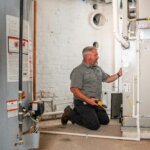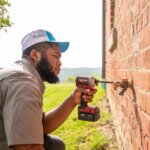As homeowners, protecting your property is a top priority. One of the most important ways to safeguard your home is by preventing basement flooding and water damage. This is where sump pumps come in; they are designed to pump excess water away from your home’s foundation and prevent water damage.
If you’re considering installing a sump pump, you’ve come to the right place. In this blog post, we’ll guide you through the important factors to consider before installing a sump pump and the steps to take for a correct installation. Let’s get started!
Considerations Before Installation
Before installing a sump pump, there are several important factors to consider. These include:
- Type of sump pump: The two main types of sump pumps are called submersible and pedestal pumps. Submersible pumps are installed in the sump pit, while pedestal pumps are installed outside the pit.
- Size of the sump pit: The capacity of the sump pump should match the amount of water entering the sump pit.
- Location of the discharge pipe: It’s important to ensure that it is located where water can be safely directed 20 feet away from your home’s foundation.
The appropriate sump pump size will depend on the basement or crawl space size and the amount of water expected. A 1/3 horsepower (hp) sump pump is generally adequate for most homes.
Necessary Tools and Materials
To install a sump pump, you will need the following tools and materials:
- Sump pump: This is the heart of the system and is responsible for pumping water out of the sump pit.
- Sump basin: This container holds the sump pump and collects water from the basement or crawl space.
- Check valve: This prevents water from flowing back into the sump pit after it has been pumped out.
- Discharge pipe: This pipe carries water from the sump pump to the outside of the house.
- Fittings: These connect the various components of the sump pump system.
As you choose materials, it’s important to use high-quality components for optimal performance and longevity. Cheap or inferior materials may fail quickly or not work as effectively, leading to repairs or replacements.
Installation Process
Now that we’ve discussed the considerations and tools for the installation, let’s go over the steps involved in the process.
- Prepare the sump pit: Before installing the sump pump, it’s important to ensure that it is clean and debris-free.
- Install the sump pump and check valve: Next, install the check valve on the discharge pipe to prevent water from flowing back into the sump pit after it has been pumped out.
- Connect the discharge pipe: Attach the discharge pipe to the sump pump and route it to the outside of the house, ensuring that it is angled away from the foundation.
- Test the pump: Once the sump pump and discharge pipe are installed, test the pump to ensure it works properly.
Following the manufacturer’s instructions and safety guidelines during installation is also important to ensure that the sump pump is installed correctly and operates safely.
Maintenance and Troubleshooting
Here are some tips for maintaining your sump pump:
- Clean the sump pit: Regularly remove any accumulated debris in the sump pit. This will help prevent clogs and keep the pump operating smoothly.
- Test the pump: Regularly fill the sump pit with water to ensure it functions correctly.
- Replace parts as needed: Replace any damaged parts promptly to avoid further damage.
If you ever face issues with your sump pump, there are some common problems that you can easily troubleshoot. One of these issues is a malfunctioning float switch.
This switch is responsible for turning the sump pump on and off, and if it’s not working correctly, the pump may not turn on when needed. To fix this problem, check the switch for debris or damage and replace it if necessary. Another common issue that can affect the performance of your sump pump is a clogged discharge pipe.
If the pipe is blocked, the sump pump won’t be able to remove water effectively from the sump pit. To restore proper function, you should clear any clogs in the pipe. You can keep your sump pump working by addressing these problems.
Benefits of Professional Sump Pump Installation
Hiring a professional plumbing company to install sump pump offers many benefits, including:
- Expertise: A professional plumber ensures your sump pump is installed correctly and properly.
- Experience: Professional plumbers have installed countless sump pumps and can quickly identify any potential issues during installation.
- Warranty: Professional installation often comes with a warranty, providing peace of mind knowing your investment is protected.
By hiring a professional plumber for sump pump installation, you can rest assured that your pump will be installed properly, reducing the risk of future water damage and potential repairs.
Protect Your Home With Professional Sump Pump Installation and Maintenance
Sump pumps play a crucial role in preventing water damage and basement flooding. By considering the necessary factors, tools, and steps for installation and tips, homeowners can protect their homes from water damage.
However, consider professional sump pump installation and maintenance to ensure it operates at its best and lasts longer. At Jolly Plumbing, our experienced plumbers can ensure that your sump pump is installed correctly and properly. Contact us today to schedule an appointment.



